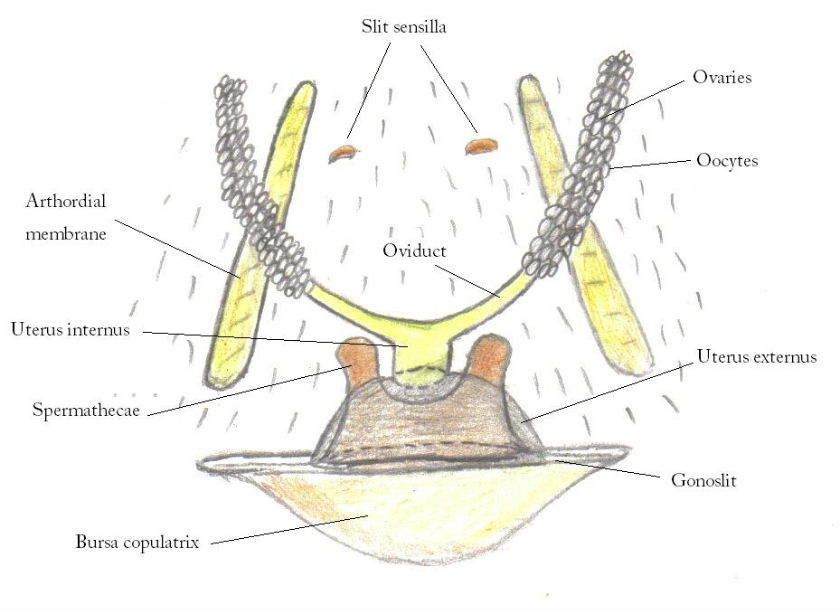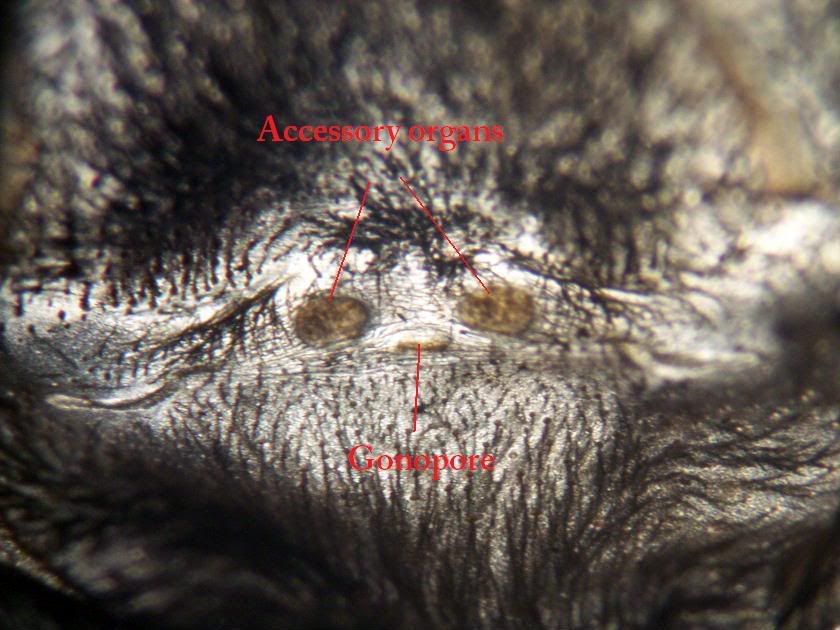The only real accurate way to sex a tarantula is by examining the epigynal area located between the anterior book lungs of the tarantulas shed skin but to do this you must first know what you are looking for.

FEMALE ANATOMY

This is a picture of the female sex organs located between the anterior book lungs (top pair).
The spermathecae. Only present in females these are the sacks where the males sperm is stored and come in a variety of shapes and sizes depending on the species They can either be a paired structure (as shown in the pic) or a fused structure (usually a singular dome or tombstone shape) and branch off from the uterus externus. Fused spermathecae will start off as a pair and later join together as the spider gets older. The spermathecae is lined with cuticle and is there for shed along with the rest of the old skin. Because of this any sperm that has been stored in the spermathecae will be lost after a moult in effect making the female virginal again. There are how ever two species in which the females do not possess spermathecae and instead store the sperm in pores in the uterus internus , these are Sickius longibulbi and Encyocratella olivacea.
The uterus externus. Only found in females this is a transparent tube of skin that connects to the uterus internus at one end and opens out to the gonoslit at the other end. The uterus externus is lined with cuticle like the spermathecae and is the only part of the uterus shed along with the rest of the old skin. It is the first point where the sperm and the eggs come into contact and is the most important feature in determining the sex of a tarantula from its shed skin.
The bursa copulatrix. This is the lower alcove that is formed below the spermathecae and the uterus externus. It is also only found on females and is believed to be the area where the sperm and the eggs mix before being deposited into the egg sack .

This drawing shows how all the parts connect with the organs that are not shed during a moult.
A brief description of other features mentioned.
Uterus internus. A short section of tube that connects to the uterus externus at one end and to the oviducts at the other. This along with the oviduct and ovaries is not shed.
Oviduct. Two tubes that lead to the overies.
Ovaries. The female reproductive organs that produce eggs (oocytes)
Slit sensilla. These are internal stress receptors that sense any stresses on the spiders exoskeleton.
Arthordial membrane. These are muscle attachments that define the left and right hand sides of the epigynum.
Gonoslit. This is the opening to the females sexual organs.

Fused spermathecae

another example of paired spermathecae

Encyocratella olivacea - note that although there is no spermathecae there is still a uterus externus and bursa copulatrix.
MALE ANATOMY

The gonopore. This is the opening in the centre of a males epigastric furrow that leads to the testes. The testes are 2 long coiled tubes that produce sperm and also act as sperm ducts.
Accessory organs. Also known as accessory glands , epigastric organs or epigastric glands. The exact function of these organs is unknown but they are said to produce an adhesive liquid that helps the sperm droplet stick to the sperm web. They can be very prominent in some species such as Brachypelma vagans and are often mistaken for paired spermathecae. These accessory glands are wider at the apex than at the base and usually look tree or mushroom shaped as opposed to spermathecae which are wider at the base than at the apex. Of course there are a few exceptions to the rule such as Poecilotheria species and Aphonopelma chalcodes for example where the male accessory glands are wider at the base than at the apex.


Close up of gonopore

You can see the male accessory organs marked in green here and the lips of the gonopore circled in red.

Pic of male accessory organs from a Poecilotheria regalis notice they are wider at the base than at the apex.
PREPARING THE SKIN
Unless you have just retrieved the skin from a freshly moulted spider then the skin will be very dry and brittle making any attempt to sex it almost impossible. The most common method to moisten the skin and make it pliable again is to soak it in water with a drop of washing up liquid however i find it is much easier just to give the skin a good spray with a mister for a few seconds.

Once the skin is pliable take hold of the abdomen skin where it joins the carapace and gently pull down on it so that the skin unwinds then cut off the excess skin below the posterior book lungs.

Next take a needle and run it down the abdomen skin from the pedicel (where the abdomen joins the cephalothorax) to the posterior book lungs and carefully open up the skin.

The skin is now ready to be sexed. Some large spiders can be sexed with the naked eye but most will need some kind of magnification. For most adult spiders anything from x2 - x20 will do and this can be achieved by using hand held lenses or jewellers loupes. For sub adults and large juveniles a higher magnification of x20 - x40 is needed and for this you will need a microscope. Finally for sexing spiderlings you will need an even higher magnification of x40 - x80
Hope this is of some help, for more information on sexing then read Sex determination of immature theraphosid spiders from their cast skins by Kathleen and John Hancock or join the BTS and enroll in the tarantula sexing course if they still do it.
